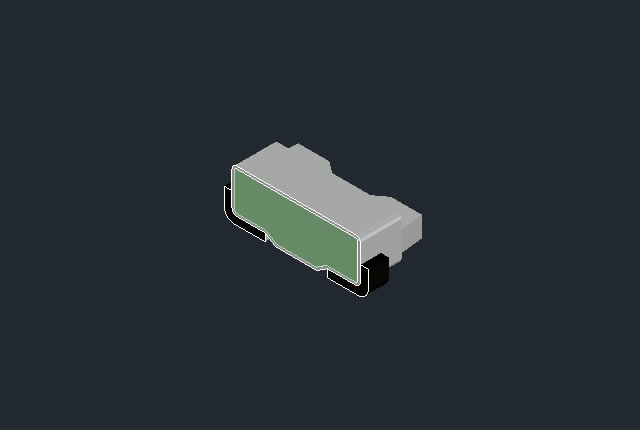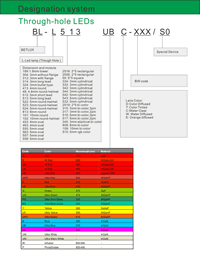Discrete LEDs package
Series No:
Weight:(g/pcs)
Dimension:(mm)
Package:
Specification:
Inquiry
Description:
“Precision Lighting in Compact Form: Exploring the 2810 SMD LED Diode 215 Side Emitting”
Introduction
In the field of compact lighting solutions and electronic design, the 2810 LED has earned its reputation as a reliable and efficient light-emitting diode, perfect for modern surface-mount applications. Designed for high brightness and directional control, the 2810 SMD LED diode 215 side emitting model delivers consistent illumination while optimizing space and energy efficiency. Its side-emitting structure allows light to project horizontally, making it ideal for applications where vertical light emission is not practical — such as edge lighting, key backlights, and low-profile display systems.
As a white LED, the 2810 series offers exceptional color stability and brightness, ensuring even illumination across devices. When integrated into a properly designed LED circuit, it provides precise optical performance with low energy consumption. For engineers, electronics manufacturers, and system designers, the SMD 2810 LED represents a reliable choice that balances form, function, and performance.
Features of the 2810 SMD LED Diode
The 2810 LED is a small yet powerful component designed to meet the rigorous demands of modern lighting systems. Its innovative side-emitting configuration makes it especially valuable in compact layouts that require controlled light direction.
Key Technical Features:
-
Compact Dimensions (2.8mm × 1.0mm):
The small SMD package allows for dense integration on PCBs while maintaining high brightness and uniform emission. -
Side-Emitting Design:
Unlike standard top-emitting LEDs, the 2810 LED projects light laterally, making it perfect for applications such as edge-lit displays and backlit panels. -
High Luminous Intensity:
Despite its miniature size, this white LED provides strong light output suitable for various optical and electronic applications. -
Energy Efficiency:
The diode is optimized to deliver high brightness at low power, reducing overall energy consumption in the LED circuit. -
Excellent Thermal Stability:
Built using thermally resistant materials to ensure stable operation and long lifespan, even in high-temperature environments. -
Long Operating Life:
With a rated lifespan of over 50,000 hours, the 2810 LED ensures reliability and durability in industrial and consumer systems alike. -
Surface-Mount Technology (SMD):
Simplifies assembly and ensures compatibility with automated manufacturing processes for large-scale production. -
Color Consistency:
The white LED offers uniform color tone and brightness consistency, critical for visual uniformity in multi-LED arrays.
Applications of the 2810 LED Diode 215 Side Emitting
The 2810 SMD LED is engineered for a broad range of electronic and lighting applications that demand compact size, directional light, and reliable operation.
-
Backlighting in Displays:
The 2810 LED is a go-to component for LCD edge lighting and keypad backlighting, ensuring consistent illumination across display edges. -
Consumer Electronics:
Used in mobile devices, laptops, and keyboards for low-profile lighting solutions that enhance usability without increasing device thickness. -
Automotive Lighting Systems:
Ideal for interior lighting, control buttons, and dashboard backlights. The SMD 2810 LED offers superior stability and uniform color rendering. -
Industrial Control Panels:
Provides indicator lighting and system feedback illumination where space constraints and reliability are essential. -
Signage and Display Modules:
The side-emitting nature of the 2810 LED makes it perfect for slim and elegant designs that demand even light distribution. -
Wearable Electronics:
The white LED provides bright yet power-efficient illumination in smart bands, watches, and fitness trackers. -
Architectural Accent Lighting:
Its lateral emission pattern is excellent for indirect or edge lighting in modern aesthetic designs.
Benefits of the 2810 SMD LED Technology
The 2810 LED diode delivers significant advantages for engineers and designers seeking performance, flexibility, and energy efficiency in compact lighting systems.
-
Enhanced Design Flexibility:
The side-emitting structure allows light to spread evenly along surfaces, enabling creative and functional illumination designs. -
Low Power Consumption:
Reduces energy requirements while maintaining excellent brightness, making it eco-friendly and cost-efficient. -
Superior Light Uniformity:
Ideal for applications that require even light diffusion, such as display backlighting and LED circuit arrays. -
Compact Form Factor:
Its small SMD footprint simplifies circuit design and allows for tighter PCB layouts without sacrificing performance. -
High Reliability:
Designed for long-term use under various operating conditions, including high humidity and temperature environments. -
Ease of Assembly:
Compatible with automated placement and reflow soldering, improving production efficiency and consistency. -
Long Operational Life:
Ensures reduced maintenance costs and reliable long-term illumination, even in demanding applications.
Case Studies
Case Study 1 – Mobile Device Backlight (South Korea):
A global smartphone manufacturer adopted the 2810 LED for its side-emitting keypad backlight solution. The design resulted in a thinner, more energy-efficient keypad with uniform brightness, reducing power consumption by 18% compared to conventional top-view LEDs.
Case Study 2 – Industrial Equipment Indicators (Germany):
An automation company integrated SMD 2810 LEDs into control panels for equipment monitoring. The side-emitting design improved readability in dimly lit factory environments, while its durability ensured stable operation over extended periods.
Case Study 3 – Automotive Dashboard (Japan):
A car manufacturer incorporated 2810 SMD LEDs into dashboard button illumination. The component’s compact design allowed for a sleeker panel structure and improved nighttime visibility with consistent white lighting.
User Testimonials
Emily Roberts, Product Designer (USA):
“We rely on the 2810 LED for precision display lighting. The side-emitting angle gives our products a refined, even glow that enhances user experience.”
Liu Chen, Manufacturing Engineer (China):
“The SMD 2810 LED has proven to be highly durable and consistent across multiple production batches. It performs well under high heat and mechanical stress.”
David Young, Lighting Technician (UK):
“Using white LEDs in our signage projects has dramatically improved brightness while keeping energy use low. The side-emitting feature provides perfect edge illumination.”
Integration in LED Circuit Design
Integrating the 2810 LED into a LED circuit requires attention to current control, heat management, and optical alignment for maximum performance.
Best Practices Include:
-
Constant Current Drivers:
Prevent voltage fluctuation, ensuring stable brightness and extending LED lifespan. -
Heat Dissipation Design:
Proper PCB material (like aluminum or copper core) helps manage thermal buildup efficiently. -
Optical Diffusion Layers:
Adding a light-diffusing film ensures smoother light distribution, particularly for display and backlighting uses. -
Voltage Regulation:
Maintaining optimal forward voltage is key to preventing overcurrent damage.
By implementing these principles, designers can maximize the 2810 LED‘s efficiency and durability while achieving consistent illumination across the system.
Conclusion
The 2810 SMD LED diode 215 side emitting model represents a breakthrough in compact, efficient lighting technology. Engineered for precision illumination, energy efficiency, and long-term reliability, it meets the demands of modern electronic designs where space is limited but performance is paramount.
As a white LED, it offers exceptional color uniformity and brightness, making it ideal for displays, signage, and smart devices. Integrated into a properly designed LED circuit, the 2810 LED ensures consistent light output and minimal power consumption, helping manufacturers and engineers achieve sleek, efficient, and reliable products.
For anyone designing advanced lighting systems or compact electronics, the SMD 2810 LED is a versatile, future-ready solution that brings together precision, performance, and durability.

Features:
-
- Compact size: 2.8mm x 1.0mm
- Side-emitting design for directional lighting
- Mono-color type with Ultra Brightness
- Compatible with automatic placement equipment
- Wide Viewing Angle for versatile applications
- Ideal for Backlighting and Indicator purposes
- Package includes 3000 pieces
Applications:
-
- Backlighting for compact electronic displays
- Indicator lights in confined spaces
- Illumination in small electronic devices
- Automotive lighting applications
- Wearable technology
- Low-profile lighting solutions
- Space-constrained electronic designs


Electrical-optical characteristics:
Package configuration & Internal circuit diagram
Obtain 3D specification files
To examine all 3D specifications, save the files to your local drive and open them with your 3D application.
Lens colors in 3D files are solely for visual representation; consult the Datasheet for accurate lens type and color information.
In the event of a mismatch, the dimensions in the datasheet take precedence over the 3D specifications.
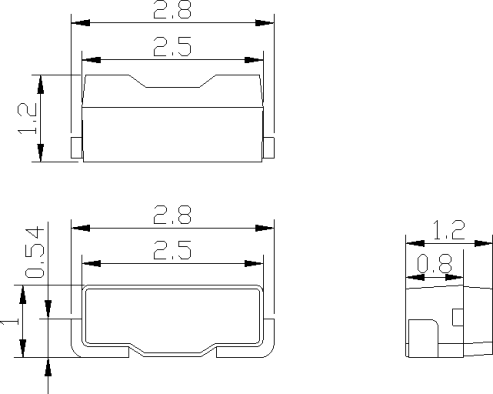
All dimensions are in millimeters(inches)
Tolerance is +-0.25(0.01″) unless otherwise note
Specifications are subject to change without notice.
Partno description:
More Information
Lens Color:
| Code | D | T | C | W | E | |
| Meaning | color Diffused | Color Tinted | Water Clear | Water Diffused | Orange diffused |
Absolute maximum ratings (Ta=25°C)
| Parameter | SR | LR | UR | UE | UY | UG | PG | BG | B | UB | UV | W | Unit |
| Forward Current I F | 25 | 25 | 25 | 30 | 30 | 30 | 30 | 30 | 30 | 30 | 30 | 30 | mA |
| Power Dissipation P d | 60 | 60 | 60 | 65 | 65 | 75 | 110 | 110 | 120 | 120 | 120 | 120 | mW |
| Reverse Voltage V R | 5 | 5 | 5 | 5 | 5 | 5 | 5 | 5 | 5 | 5 | 5 | 5 | V |
| Peak Forward Current I PF (Duty 1/10 @1KHZ) | 150 | 150 | 150 | 150 | 150 | 150 | 150 | 100 | 100 | 100 | 100 | 100 | mA |
| Operation Temperature T OPR | -40 to +80 | °C | |||||||||||
| Storage Temperature T STG | -40 to +85 | °C | |||||||||||
| Lead Soldering Temperature T SOL | Max.260+-5°C for 3 sec Max. (1.6mm from the base of the epoxy bulb) | °C | |||||||||||
Related Information
Applied for:

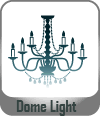
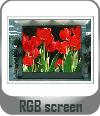
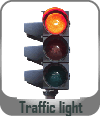
The LEDs described here are intended to be used for ordinary electronic equipment (such as office equipment,
communication equipment and household applications). Consult Betlux’s Sales in advance for information on
applications in which exceptional reliability is required, particularly when the failure or malfunction of the LEDs
may directly jeopardize life or health (such as in aviation, transportation, traffic control equipment, medical
and life support systems and safety devices).
CAUTIONS for Through-Hole LED Lamps
1. Application
The LEDs described here are intended to be used for ordinary electronic equipment (such as office equipment, communication equipment and household applications). Consult Betlux’s Sales in advance for information on applications in which exceptional reliability is required, particularly when the failure or malfunction of the LEDs may directly jeopardize life or health (such as in aviation, transportation, traffic control equipment, medical and life support systems and safety devices).
2. Storage
The storage ambient for the LEDs should not exceed 30℃ temperature or 70% relative humidity. It is
recommended that LEDs out of their original packaging are used within three months
For extended storage out of their original packaging, it is recommended that the LEDs be stored in a sealed
container with appropriate desiccant or in a desiccator with nitrogen ambient.
3. Cleaning
Use alcohol-based cleaning solvents such as isopropyl alcohol to clean the LED if necessary
4. Lead Forming & Assembly
During lead forming, the leads should be bent at a point at least 3mm from the base of LED lens. Do not use
the base of the leadframe as a fulcrum during forming.
Lead forming must be done before soldering, at normal temperature.
During assembly on PCB, use minimum clinch force possible to avoid excessive mechanical stress.

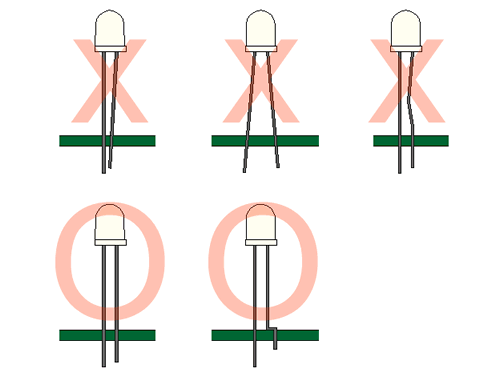
Soldering
When soldering, leave a minimum of 2mm clearance from the base of the base of the lens to the soldering point. Dipping the lens into the solder must be avoided.
Do not apply any external stress to the lead frame during soldering while the LED is at high temperature.
Recommended soldering conditions:
| IR Reflow Soldering (for SMD display) | Wave Soldering | Soldering Iron | |||
| Pre-Heat | 150-180°C | Pre-Heat | 100°C Max. | Temperature | 300°C Max. |
| Pre-Heat Time | 120sec Max. | Pre-Heat Time | 60sec Max. | ||
| Peak Temperature | 260°C Max. | SolderWave | 260°C Max. | Soldering Time | 3sec Max.(one time only) |
| Soldering Time | 10 sec Max. | Soldering Time | 5sec Max. | ||
Note: Excessive soldering temperature and/or time might result in deformation of the LED lens or failure of the LED
ESD(Electrostatic Discharge)
Static Electricity or power surge will damage the LED.
Suggestions to prevent ESD (Electrostatic Discharge):
n Use a conductive wrist band or anti-electrostatic glove when handling these LEDs
n All devices, equipment, and machinery must be properly grounded
n Work tables, storage racks, etc. should be properly grounded
n Use ion blower to neutralize the static charge which might have built up on surface of the LED’s
plastic lens as a result of friction between LEDs during storage and handling
ESD-damaged LEDs will exhibit abnormal characteristics such as high reverse leakage current,
low forward voltage, or “no light on” at low currents. To verify for ESD damage, check for “light on”
and Vf of the suspect LEDs at low currents.
The Vf of “good” LEDs should be>2.0V@0.1mA for InGaN product and >1.4V@0.1mA for AlInGaP
product.

Drive Method
An LED is a current-operated device. In order to ensure intensity uniformity on multiple LEDs connected in
parallel in an application, it is recommended that a current limiting resistor be incorporated in the drive circuit,
in series with each LED as shown in Circuit A below.
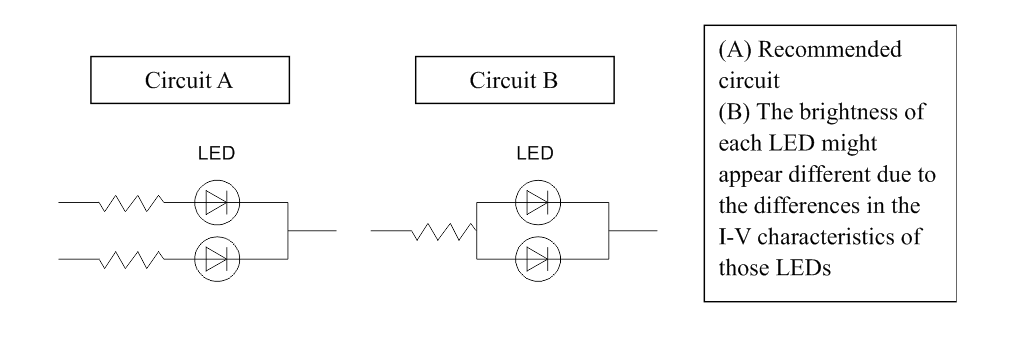
When selecting power for LED systems, it’s essential to understand several key parameters to ensure safe operation, longevity, and optimal performance. Here are some steps and considerations for LED power selection:
- Determine the Forward Voltage (Vf) of the LED(s):
Each LED has a forward voltage, which is the voltage at which the LED operates when the current is flowing through it. This value can typically be found in the LED’s datasheet.
- Determine the Forward Current (If) of the LED(s):
The forward current is the current at which the LED is designed to operate. Running an LED at higher than its rated current can reduce its lifespan and increase the heat it produces.
- Decide on the Configuration:
Series Configuration: When LEDs are connected in series, the forward voltages add up, but the current remains the same.
Parallel Configuration: When LEDs are connected in parallel, the forward voltage remains the same, but the currents add up. This configuration can be risky because if one LED fails or has a slightly lower forward voltage, it can cause the other LEDs to draw more current.
Calculate Total Power Requirements:
Power (W) = Total Forward Voltage (V) x Total Forward Current (A)
For example, if you have three LEDs connected in series, each with a forward voltage of 3V and a forward current of 20mA, the total power requirement would be:
Power = (3V + 3V + 3V) x 20mA = 9V x 0.02A = 0.18W
- Select an Appropriate Power Supply:
- Voltage Rating: The power supply voltage should match or slightly exceed the total forward voltage of your LED configuration.
- Current Rating: The power supply’s current rating should meet or exceed the total forward current of your LED configuration.
- Safety Margin: It’s a good practice to select a power supply that can provide at least 20% more power than your calculated requirement. This ensures the power supply isn’t operating at its maximum capacity, which can extend its life and ensure safer operation.
- Consider Additional Features:
- Dimming Capability: If you want to control the brightness of your LEDs, choose a power supply with dimming capabilities.
- Overcurrent and Overvoltage Protection: To protect your LEDs, select a power supply with built-in protection mechanisms.
- Thermal Management: Ensure that the power supply has adequate cooling, especially if it will be enclosed or in a location with limited airflow.
- Regulation and Efficiency:A power supply with good regulation will maintain a consistent voltage output despite variations in the load. High efficiency ensures minimal power is wasted as heat.
- Physical Size and Form Factor:Depending on where you plan to place the power supply, its size and shape may be critical factors.
In summary, when selecting power for LED systems, understanding your LED’s requirements and the configuration you plan to use is essential. Then, pick a power supply that meets those needs with some added safety margin, keeping in mind any additional features or constraints relevant to your project.
Here are some well-regarded brands in the industry:
- Mean Well: One of the most recognized brands in the LED power supply industry, Mean Well offers a wide range of products suitable for both indoor and outdoor applications. Their units often come with features like overcurrent protection, dimming capabilities, and high efficiency.
- Tridonic: A global leader in lighting technology, Tridonic offers LED drivers and power supplies that cater to various lighting solutions, from simple setups to advanced smart lighting systems.
- Philips Advance Xitanium: Philips is a well-known brand in the lighting industry, and their Xitanium series of LED drivers are known for reliability and performance. They cater to both indoor and outdoor LED applications.
- Osram: Another giant in the lighting industry, Osram offers a range of LED drivers and power supplies suitable for various applications, including architectural and street lighting.
- LIFUD: Specializing in LED drivers, LIFUD is known for its high-quality products that cater to both commercial and residential LED lighting solutions.
- MOSO: This brand offers a variety of LED drivers, especially for outdoor and industrial applications. Their products are known for durability and performance.
- TDK-Lambda: With a history in power electronics, TDK-Lambda offers a range of power supplies and LED drivers suitable for various applications, emphasizing reliability and advanced features.
Need help?
Related products
-

LED de tres dígitos de 0,4 pulgadas
Quick View View products -

pantalla led de tres dígitos y siete segmentos de 0,40 pulgadas
Quick View View products -

pantalla de tres dígitos de 0,52 pulgadas
Quick View View products -

pantalla led de tres dígitos y siete segmentos de 0,50 pulgadas
Quick View View products
